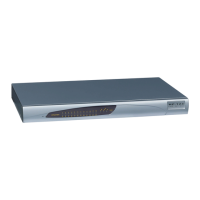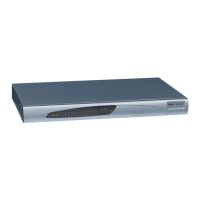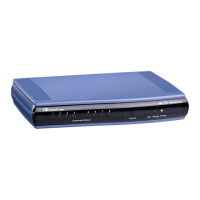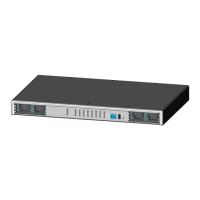User's Manual 276 Document #: LTRT-27045
Mediant 1000B Gateway & E-SBC
3. Configure an HTTP Proxy service according to the parameters described in the table
below.
4. Click Apply, and then save your settings to flash memory.
Table 15-21: HTTP Proxy Services Table Parameter Descriptions
Parameter Description
Index
[HTTPProxyService_Index]
Defines an index number for the new table row.
Note:
Each row must be configured with a unique index.
The parameter is mandatory.
Name
service-name
[HTTPProxyService_ServiceName]
Defines an arbitrary name to easily identify the row.
The valid value is a string of up to 40 characters. By default,
no value is defined.
Note:
Each row must be configured with a unique name.
The parameter is mandatory.
Listening Interface
listening-int
[HTTPProxyService_ListeningInterface]
Assigns an HTTP Interface to the HTTP Proxy service. To
configure HTTP Interfaces, see ''Configuring HTTP
Interfaces'' on page 273.
Note: The parameter is mandatory.
URL Prefix
url-prefix
[HTTPProxyService_URLPrefix]
Defines the URL prefix that is used to access the managed
equipment's embedded Web server. The URL prefix is
matched against the target of the HTTP requests sent by
the client (such as GET and POST). If a match is located in
the table, the device removes the prefix from the request
and then forwards the HTTP request to the managed
equipment without the prefix. For example, for the URL of
GET /home/index.html HTTP/1.1 (which is part of the URL
http://10.20.30.40/home/index.html), a URL prefix of
“/home” can be configured. To match all URLs, configure
the parameter to "/" (default).
Keep-Alive Mode
keep-alive-mode
[HTTPProxyService_KeepAliveMode]
Enables a keep-alive mechanism with the managed
equipment:
[0] Disable
[1] Options = (Default) Enables keep-alive by sending
HTTP OPTIONS messages. If no response is received
from the HTTP host, the device stops forwarding HTTP
requests to the host and raises an SNMP alarm
(acHTTPProxyServiceAlarm). If you configured the
address of the host as an FQDN (see ''
Proxy Hosts'' on page 276) and the DNS resolution
results in multiple IP addresses, when no response is
received from the keep-alive, the device checks
connectivity with the next resolved IP address and so on,
until a response is received.
15.6.3.1 Configuring HTTP Proxy Hosts
The HTTP Proxy Hosts table lets you configure HTTP Proxy hosts for HTTP Proxy
services. An HTTP Proxy Host represents the HTTP-based managed equipment (e.g., IP
Phone). The table is a "child" of the HTTP Proxy Services table (see ''Configuring HTTP

